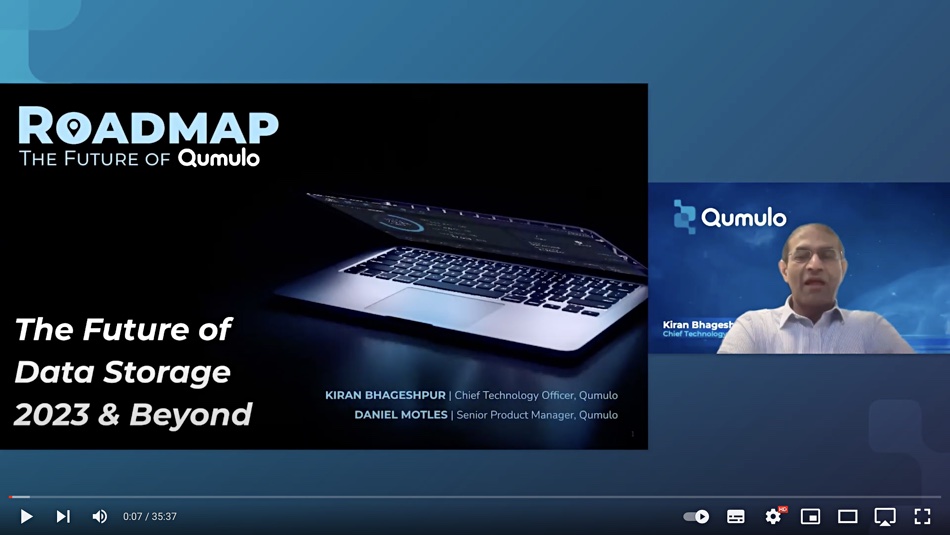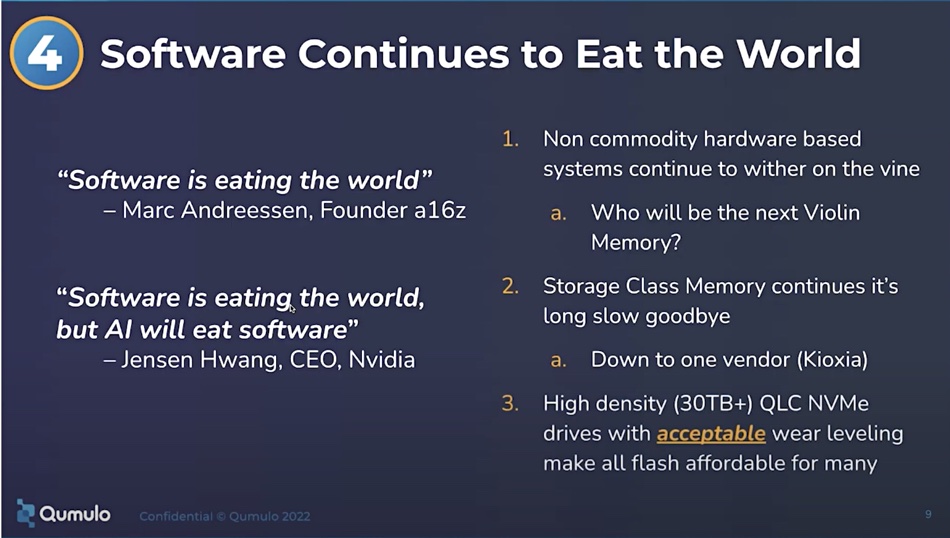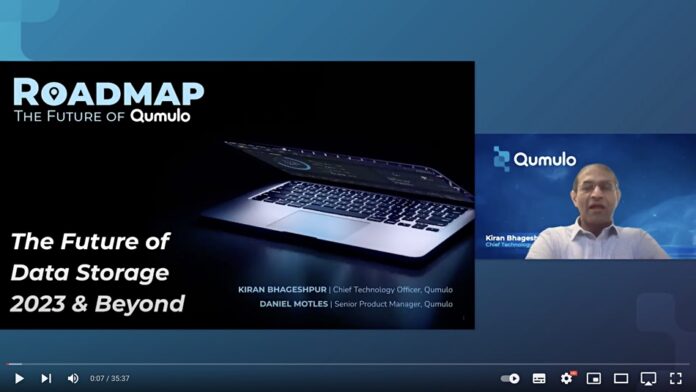Qumulo wants to make its file services available anywhere in a customer’s IT environment – that means on-premises, public cloud and from any business location, via clusters that are globally managed through a single namespace.
The major product line is scaleout Core filer software that runs on clusters of x86 commercial off-the shelf hardware, including Qumulo-branded hardware (P, C, K series) from Arrow and third-party file storage systems from OEMs such as HPE, Fujitsu, Quanta, Supermicro and Western Digital. Cluster nodes can be hybrid systems, including disk drives and NVMe SSDs, or all-flash. Qumulo also supports public clouds such as AWS, Azure, and GCP with data access by NFS, SMB, FTP and S3.
The ambition was spelled out by CTO Kiran Bhageshpur, filling in some of the blanks in Qumulo’s product development directions, in a Roadmap – Future Of Qumulo webinar. He said: “Our real vision is to run anywhere, on any platform, and at scale. And, we want to do it simply. We want to make certain you have the best performance, as well as the best cost point across all of your locations. We also want to simplify management down to one interface that manages all of that data with one namespace to stitch them all together. That’s our north star.”

Bhageshpur listed the main IT trends he saw affecting the market:
- AI and machine learning will become mainstream and the datasets involved double or more in size,
- IaaS in the cloud will outpace on-premises infrastructure growth,
- File-based applications will be more prevalent in the public cloud, with large file dataset (100s of TB to 10s of PBs) workloads using the cloud,
- Data, meaning files, needs to be accessed and managed from anywhere,
- Distributed hybrid working is the new normal,
- Software-defined storage needs commercial off-the-shelf hardware, proprietary hardware will become less popular,and who will be the next Violin Memory?
- Storage-class memory is on the way out with only one vendor: Kioxia
- 30 – 60TB QLC NVMe flash drives will become mainstream, and Qumulo will support this hardware,
- Co-ordinated government actions will reduce cyber attack frequency.

Security will also provide a business boost, Bhageshpur said: “We’re going to see western-style governments start coordinating and being very active and pre-emptive against militia cyber actors. In the past, when this happened it was the company’s problem. Going forward, it’s going to be a nation-state problem because they’re targeting critical infrastructure.”

Edge system data services support with VMware and Docker will be coming soon.
Bhageshpur said: “We have always had the ability to deploy something at the edge in an OVA or as a VM. That’s not a technology problem. But where we sit here is use cases and packaging and how do you consume it, how do you manage it and so on, and that is something that we are still working through with customers and prospects.”
He added: “It’s not about a large amount of storage. You’re talking about single digit terabytes to low double digit terabytes but at endpoint locations which could be dozens to hundreds in size. … Vision wise our goal is: “Hey wouldn’t you like Qumulo files on VMware just like you have vSAN on VMware and that’s kind of where we want to go.”
Qumulo will support three more system vendor’s server platforms and improve its public cloud offering: “What I want to tease you with is: think about Cloud file that is cost competitive with file on premises.”
The in-preview Azure Native Qumulo Scalable File Service (ANQSFS) is the Qumulo stack ported to Azure and making Qumulo file services available on Azure exactly the same way as Qumulo on-premises. B&F looks forward to AWS and Google Cloud implementations of this, and notes a resemblance to Azure NetApp Files and NetApp’s FSx for ONTAP. We are seeing a cross-cloud and on-premises Qumulo data fabric being created here.
A replication engine can move, Qumulo says, massive amounts of data between the clouds and on-premises Qumulo environments.
ANQSFS will move into full availability mode later this year.
Management efficiency is intended be improved and costs reduced by it having a single global namespace within which a customer’s edge, datacenter and public cloud Qumulo deployments can be monitored and managed. Qumulo will add features later this year to make geographically-distributed teams better able to handle data-heavy workflows.

It will give its clusters more multi-tenancy features, and tuneable data protection facilities (Adaptable Data Protection) as they scale in size (node count), and also increase anti-ransomware functionality to both protect more and detect better. (Think immutable snapshots.) There will be one license to cover Qumulo installations across all of a customer’s locations.
Regarding QLC flash adoption Bhageshpur said: “It’s completely reasonable to expect two and a half petabytes usable in four rack units which is all Flash and it’s actually reasonably affordable.”
The Roadmap – Future of Storage webinar presentation is available on YouTube.








